OpenMusic Tutorials
Prev| Chapter 11. The Maquette| Next
Tutorial 33: Introduction to the Maquette II
Topics
Passing data between Temporalbox objects in a Maquette.
Key Modules Used
Maquette, Temporalbox,
om//, permut-random,
x-diff, omloop
The Concept:
In this tutorial we will use two Temporalboxes, one representing a six-note series randomly permuted at each evaluation, the other representing a Chord. This Chord will be the chromatic complement of our series, and will be put into a random register at each evaluation.
We can see that one Temporalbox depends on another here. In order to accomplish this, we’ll need to pass data about the series from the one to the other in order that the complement can be constructed.
The Patch:
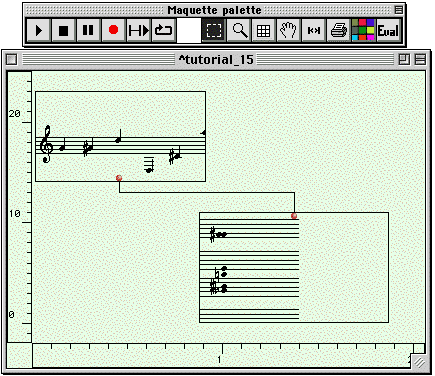
Let’s look inside the first Temporalbox:
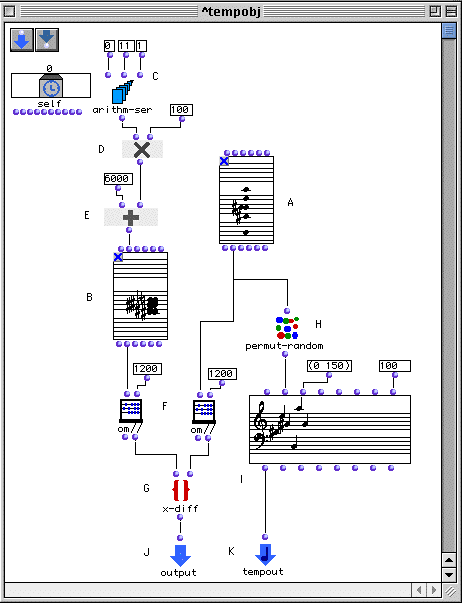
The Chord at (A) represents our series, entered in the usual way in order mode:
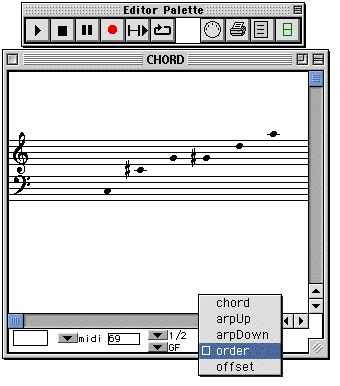
Note that the order of the series here is not important due to the fact that we will randomly permute it.
In order to get the chromatic complement of our Chord (A),
we build a chromatic scale that from which the notes of (A) will be
subtracted. In (B) we have constructed the total chromatic scale using
arithm-ser (C) which outputs the list (0 1 2 3 4 5 6 8 9
10 11), which is multiplied by 100 to get midics. These intervals will all be
added to 6000 (middle C), returning (6000 6100 6200 etc… ) at (E).
The problem now is that our scale (B) going from 6000 to 7100 midics covers only one octave. The pitch class C is represented only by the midic 6000. If we compare it to a C in any other octave, our patch will fail to recognize it as the same note in a different register because they have different midics.
To get around this, we use om//, which performs
euclidian division (i.e. division with remainder) a number or list. The
quotient is returned at the first input and the remainder at the second. We
will divide everything by the octave in midics, 1200. In other words, we will
use a modulo 1200 on our scale by taking only the remainder of the note when
divided by 1200. All Cs are multiples of 1200. They will divide with a
remainder of 0. All Ds are 200 midics above a multiple of 1200 and will divide
with a remainder of 200. In this way we reduce both our chromatic scale and
the series to raw pitch class. (F)
The outputs of the two om// boxes will be compared by
the x-diff funtion which returns the list of elements present
in the first input but not in the second, therefore returning the notes of the
chromatic scale not found in our series, i.e. the complement. This result will
go out through an output added especially for this purpose at (J).
What actually gets played is a Chord-seq generated from
our series with the permut-random function at (H). It
is passed to tempout so that it will play.
In the second Temporalbox, we will add a random multiple of 1200 to all the pitches retrieved from the first box via an input specially added:
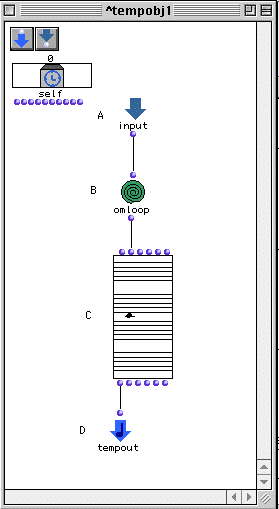
…and the interior of the omloop:
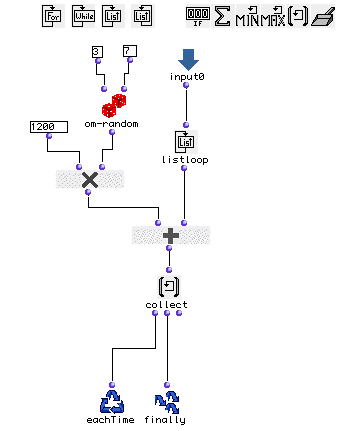
…is pretty straightforward. The notes of the complementary chord are
enumerated one by one by listloop. Each time, om-
random generates a number between 3 and 7 which is
multiplied by 1200 and added to the pitch, putting it in effect in a random
octave. The results are collected by collect and output by
finally.
The output of the loop needs to be put into a playable musical object and
connected to the tempout. We chose a Chord, so they’ll be
played simultaneously, but you can (and should) replace them with Chord-
seq objects.
Remember to click Eval before playing the Maquette. Remember also that you can copy boxes by option-dragging them. In this way you can fill the Maquette with random notes and chords:
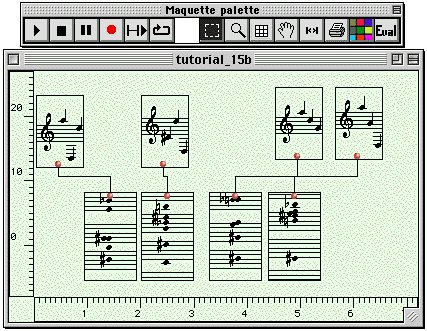
| Prev | Home | Next |
|---|---|---|
| Tutorial 32: Introduction to the Maquette I | ||
| Up | Lambda Functions |